List of Roman emperors

The Roman Emperors were men who ruled the Roman Empire and wielded power over its citizens and military. The empire was developed as the Roman Republic invaded and occupied the majority of Europe. Under the republic, regions of the empire were ruled by provincial governors answerable and authorised by the "Senate and People of Rome". Rome and its senate were ruled by a variety of magistrates – of whom the consuls were the most powerful. The republic ended, and the emperors were created, when these magistrates became legally and practically subservient to one citizen with power over all other magistrates. Augustus, the first emperor, was careful to maintain the facade of republican rule, taking no specific title for his position[1] and calling the concentration of magisterial power Princeps Senatus (the first man of the senate).[1] This style of government lasted for 300 years, and is thus called the Principate era. The modern word 'emperor' derives from the title imperator, which was granted by an army to a successful general; during the initial phase of the empire, it still had to be earned by the 'Princeps'. The term emperor is a modern construction, used when describing rulers of the Roman Empire because it emphasises the strong links between the ruler and the army (on whose support the ruler's power depended), and does not discriminate between the personal styles of rule and titles in different phases of the Empire.
In the late 3rd century, after the Crisis of the Third Century, Diocletian formalised and embellished the recent manner of imperial rule, establishing the so-called 'Dominate' period of the Roman Empire. This was characterised by the explicit increase of authority in the person of the Emperor, and the use of the style 'Dominus Noster' ('Our Lord'). The rise of powerful Barbarian tribes along the borders of the empire and the challenge they posed to defense of far-flung borders and unstable imperial succession led Diocletian to experiment with sharing imperial titles and responsibilities among several individuals - a partial reversion to pre-Augustian Roman traditions. For nearly two centuries thereafter there was often more than one emperor at a time, frequently dividing the administration of the vast territories between them. As Henry Moss warned, "Yet it is important to remember that in the eyes of contemporaries the Empire was still one and indivisible. It is false to the ideas of this time to speak of 'the Eastern and Western Empire'; the two halves of Empire were thought of as 'the Eastern, or Western parts' (partes orientis vel occidentis.)"[2] However, after the death of Theodosius I (395), the split became firmly entrenched (see: Western and Eastern)[3] The last pretense of such division was formally ended by Zeno after the death of Julius Nepos in 480. For the remaining thousand years of Roman history there would only ever be one legitimate senior emperor, ruling from Constantinople and maintaining claim to the increasingly unstable territories in the west. After 480, multiple claims to be the imperial title of Augustus (or Basileus for Greek speakers) necessarily meant civil war, although the experiment with designating junior emperors (called now Caesars), usually to indicate the intended successor, occasionally reappeared.
The Empire and chain of emperors continued until the death of Constantine XI and the capture of Constantinople by the Ottoman Empire in 1453.[4] The use of the terms "Byzantium," "Byzantine Empire," and "Byzantine Emperor" to refer to the medieval period of the Empire has been common, but not universal, among Western scholars since the 18th century, and continues to be a subject of specialist debate today.[5] The listing of the Eastern Emperors in this article ends at the start of the 7th century with Maurice, last of the Justinian dynasty, whose reign concludes the final era of Late Antiquity.[6]
Legitimacy
The emperors listed in this article are those generally agreed to have been 'legitimate' emperors, and who appear in published regnal lists.[7][8][9] The word 'legitimate' is used by most authors, but usually without clear definition, perhaps not surprisingly, since the emperorship was itself rather vaguely defined legally. In Augustus' original formulation, the princeps was selected by either the Senate or "the people" of Rome, but quite quickly the legions became an acknowledged stand-in for "the people." A person could be proclaimed as emperor by their troops or by "the mob" in the street, but in theory needed to be confirmed by the Senate. The coercion that frequently resulted was implied in this formulation. Furthermore, a sitting emperor was empowered to name a successor and take him on as apprentice in government and in that case the Senate had no role to play, although it sometimes did when a successor lacked the power to inhibit bids by rival claimants. By the medieval (or "Byzantine") period, the very definition of the Senate became vague as well, adding to the complication.[10]
Lists of legitimate emperors are therefore partly influenced by the subjective views of those compiling them, and also partly by historical convention. Many of the 'legitimate' emperors listed here acceded to the position by usurpation, and many 'illegitimate' claimants had a legitimate claim to the position. Historically, the following criteria have been used to derive emperor lists:
- Any individual who undisputedly ruled the whole Empire, at some point, is a 'legitimate emperor'(1).
- Any individual who was nominated as heir or co-emperor by a legitimate emperor (1), and who succeeded to rule in his own right, is a legitimate emperor (2).
- Where there were multiple claimants, and none were legitimate heirs, the claimant accepted by the Roman Senate as emperor is the legitimate emperor (3), at least during the Principate.
So for instance, Aurelian, though acceding to the throne by usurpation, was the sole and undisputed monarch between 270–275 AD, and thus was a legitimate emperor. Gallienus, though not in control of the whole Empire, and plagued by other claimants, was the legitimate heir of (the legitimate emperor) Valerian. Claudius Gothicus, though acceding illegally, and not in control of the whole Empire, was the only claimant accepted by the Senate, and thus, for his reign, was the legitimate emperor. Equally, during the Year of the Four Emperors, all claimants, though not undisputed, were at some point accepted by the Senate and are thus included; conversely, during the Year of the Five Emperors neither Pescennius Niger nor Clodius Albinus were accepted by the Senate, and are thus not included. There are a few examples where individuals were made co-emperor, but never wielded power in their own right (typically the child of an emperor); these emperors are legitimate, but are not included in regnal lists, and in this article are listed together with the 'senior' emperor.
Emperors after 395
After 395, the list of emperors in the East is based on the same general criteria, with the exception that the emperor only had to be in undisputed control of the Eastern part of the empire, or be the legitimate heir of the Eastern emperor.
The situation in the West is more complex. Throughout the final years of the Western Empire (395–480) the Eastern emperor was considered the senior emperor, and a Western emperor was only legitimate if recognized as such by the Eastern emperor. Furthermore, after 455 the Western emperor ceased to be a relevant figure and there was sometimes no claimant at all. For the sake of historical completeness, all Western Emperors after 455 are included in this list, even if they were not recognized by the Eastern Empire;[11] some of these technically illegitimate emperors are included in regnal lists, while others are not. For instance, Romulus Augustulus was technically a usurper who ruled only the Italian peninsula and was never legally recognized. However, he was traditionally considered the "last Roman Emperor" by 18th and 19th century western scholars and his overthrow by Odoacer used as the marking point between historical epochs, and as such he is usually included in regnal lists. However, modern scholarship has confirmed that Romulus Augustulus' predecessor, Julius Nepos continued to rule as Emperor in the other Western holdings and as a figurehead for Odoacer's rule in Italy until Nepos' death in 480. Since the question of what constitutes an emperor can be ambiguous, and dating the "fall of the Western Empire" arbitrary, this list includes details of both figures.
The Principate
Julio-Claudian dynasty
| Portrait | Name | Birth | Succession | Reign | Death | Time in Office |
|---|---|---|---|---|---|---|

|
Augustus IMPERATOR CAESAR DIVI FILIVS AVGVSTVS |
September 23 63 BC, Rome, Italia | Great-nephew and adopted son of Julius Caesar; became de facto emperor as a result of the 'first settlement' between himself and the Roman Senate. | January 16, 27 BC – August 19, 14 AD | August 19, 14 AD Natural causes or perhaps Poisoning by his wife, Livia [12] |
40 Years, 7 Months and 3 days |

|
Tiberius TIBERIVS IVLIVS CAESAR AVGVSTVS |
November 16 42 BC, Rome | Natural son of Livia Drusilla, Augustus' third wife, by a previous marriage; adopted by Augustus as his son and heir. | September 18, 14 AD – March 16, 37 AD | March 16, 37 AD Probably natural causes, possibly assassinated by Caligula |
22 Years, 5 Months and 27 days |

|
Caligula GAIVS IVLIVS CAESAR AVGVSTVS GERMANICVS |
August 31, 12 AD, Antium, Italia | Great-nephew and adoptive grandson of Tiberius, natural son of Germanicus, great-grandson of Augustus. | March 18, 37 AD – January 24, 41 AD | January 24, 41 AD Assassinated in a conspiracy involving senators and Praetorian Guards. |
3 Years, 10 Months and 6 days |

|
Claudius TIBERIVS CLAVDIVS CAESAR AVGVSTVS GERMANICVS |
August 1, 10 BC, Lugdunum, Gallia Lugdunensis | Nephew of Tiberius, brother of Germanicus, uncle of Caligula, and great-nephew of Augustus; proclaimed emperor by the Praetorian Guard. | January 25/26, 41 AD – October 13, 54 AD | October 13, 54 AD Probably poisoned by his wife Agrippina the Younger, in favour of her son Nero, possibly natural causes. |
13 Years, 9 Months |
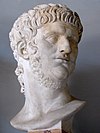
|
Nero NERO CLAUDIVS CAESAR AVGVSTVS GERMANICVS |
December 15, 37 AD, Antium, Italia | Grandson of Germanicus, nephew of Caligula, great-great-nephew of Tiberius, and great-great-grandson of Augustus; great-nephew, stepson, son-in-law, and adopted son of Claudius. | October 13, 54 AD – June 9, 68 AD | June 9, 68 AD Committed suicide after being declared a public enemy by the Senate. |
13 Years, 8 Months |
Year of the Four Emperors and Flavian Dynasty
| Portrait | Name | Birth | Succession | Reign | Death | Time in Office |
|---|---|---|---|---|---|---|
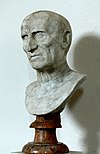
|
Galba SERVIVS SVLPICIVS GALBA CAESAR AVGVSTVS |
December 24 3 BC, Near Terracina, Italia | Seized power after Nero's suicide, with support of the Spanish legions | June 8, 68 AD – January 15, 69 AD | January 15, 69 AD Murdered by Praetorian Guard in coup led by Otho. |
7 Months & 7 days |

|
Otho MARCVS SALVIVS OTHO CAESAR AVGVSTVS |
April 28, 32 AD, Ferentinum, Etruria, Italia | Appointed by Praetorian Guard | January 15, 69 AD – April 16, 69 AD | April 16, 69 AD Committed suicide after losing Battle of Bedriacum to Vitellius |
3 months 1 day (91 days) |
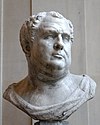
|
Vitellius AVLVS VITELLIVS GERMANICVS AVGVSTVS |
September 24, 15 AD, Rome | Seized power with support of German Legions (in opposition to Galba/Otho) | April 17, 69 AD – December 20, 69 AD | December 20, 69 AD Murdered by Vespasian's troops |
8 Months |

|
Vespasian TITVS FLAVIVS CAESAR VESPASIANVS AVGVSTVS |
November 17, 9 AD, Falacrine, Italia | Seized power with the support of the eastern Legions (in opposition to Vitellius) | December 21, 69 AD – June 24, 79 AD | June 24, 79 AD Natural causes |
10 years |
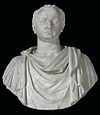
|
Titus TITVS FLAVIVS CAESAR VESPASIANVS AVGVSTVS |
December 30, 39 AD, Rome | Son of Vespasian | June 24, 79 AD – September 13, 81 AD | September 13, 81 AD Natural causes (fever) |
2 years, 3 months |

|
Domitian TITVS FLAVIVS CAESAR DOMITIANVS AVGVSTVS |
October 24, 51 AD, Rome | Son of Vespasian | September 14, 81 AD – September 18, 96 AD | September 18, 96 AD Assassinated by court officials |
15 years |
Nerva-Antonine dynasty
| Portrait | Name | Birth | Succession | Reign | Death | Time in Office |
|---|---|---|---|---|---|---|

|
Nerva MARCVS COCCEIVS NERVA CAESAR AVGVSTVS |
November 8, 30 AD, Narni, Italia | Appointed by the Senate | September 18, 96 AD – January 27, 98 AD | January 27, 98 AD Natural causes |
1 year, 4 months |

|
Trajan CAESAR MARCVS VLPIVS NERVA TRAIANVS AVGVSTVS |
September 18, 53 AD, Italica, Hispania Baetica | Adopted son and heir of Nerva | January 28, 98 AD – August 7, 117 AD | August 7, 117 AD Natural causes |
19 years, 7 months |
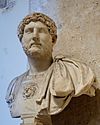
|
Hadrian CAESAR PVBLIVS AELIVS TRAIANVS HADRIANVS AVGVSTVS |
January 24, 76 AD, Italica, Hispania Baetica (or Rome) | Adopted son and heir of Trajan | August 11, 117 AD – July 10, 138 AD | July 10, 138 AD Natural causes |
21 years |

|
Antoninus Pius CAESAR TITVS AELIVS HADRIANVS ANTONINVS AVGVSTVS PIVS |
September 19, 86 AD, Near Lanuvium, Italia | Adopted son and heir of Hadrian | July 10, 138 AD – March 7, 161 AD | March 7, 161 AD Natural causes |
22 years, 7 months |

|
Marcus Aurelius CAESAR MARCVS AVRELIVS ANTONINVS AVGVSTVS |
April 26, 121 AD, Rome | Adopted son and heir of Antoninus Pius; Co-emperor with Lucius Verus until 169 AD | March 7, 161 AD – March 17, 180 AD | March 17, 180 AD Natural causes (Plague) |
19 years |

|
Lucius Verus CAESAR LVCIVS AVRELIVS VERVS AVGVSTVS |
December 15, 130 AD, Rome | Adopted son and heir of Antoninus Pius; Co-emperor with Marcus Aurelius until death | March 7, 161 AD – ? March 169 AD | March 169 AD Natural causes (Plague) |
8 years |

|
Commodus CAESAR MARCVS AVRELIVS COMMODVS ANTONINVS AVGVSTVS |
August 31, 161 AD, Lanuvium, Italia | Natural son of Marcus Aurelius; joint emperor from 177 AD | 177 AD – December 31, 192 AD | December 31, 192 AD Assassinated in palace, strangled to death |
15 years |
Year of the Five Emperors & Severan dynasty
| Portrait | Name | Birth | Succession | Reign | Death | Time in Office |
|---|---|---|---|---|---|---|

|
Pertinax CAESAR PVBLIVS HELVIVS PERTINAX AVGVSTVS |
August 1, 126 AD, Alba, Italia | Proclaimed emperor by Praetorian Guard | January 1, 193 AD – March 28, 193 AD | March 28, 193 AD Murdered by Praetorian Guard |
3 months |

|
Didius Julianus CAESAR MARCVS DIDIVS SEVERVS IVLIANVS AVGVSTVS |
133 or 137 AD, Milan, Italia | Won auction held by the Praetorian Guard for the position of emperor | March 28, 193 AD – June 1, 193 AD | June 1, 193 AD Executed on orders of the Senate |
2 months, 4 days (65 days) |

|
Septimius Severus CAESAR LVCIVS SEPTIMIVS SEVERVS PERTINAX AVGVSTVS |
April 11, 145 AD, Leptis Magna, Libya | Seized power with support of Pannonian legions[13] | April 9, 193 AD – February 4, 211 AD | February 4, 211 AD Natural causes |
17 years, 10 months |

|
Caracalla CAESAR MARCVS AVRELIVS SEVERVS ANTONINVS PIVS AVGVSTVS |
April 4, 188 AD, Lugdunum, Gallia Lugdunensis | Son of Septimius Severus; co-emperor with Severus from 198 AD; with Severus and Geta from 209 AD until February 211 AD; co-emperor with Geta until December 211 AD | 198 AD – April 8, 217 AD | April 8, 217 AD Murdered by a soldier as part of a conspiracy involving Macrinus |
19 years |

|
Geta CAESAR PVBLIVS SEPTIMIVS GETA AVGVSTUS |
March 7, 189 AD, Rome | Son of Septimius Severus; co-emperor with Severus and Caracalla from 209 AD until February 211 AD; co-emperor with Caracalla until December 211 AD | 209 AD – December 26, 211 AD | December 19, 211 AD Murdered on the orders of Caracalla |
3 years |
| File:055 Diadumenianus.jpg | Macrinus MARCVS OPELLIVS SEVERVS MACRINVS AVGVSTVS PIVS FELIX with Diadumenian MARCVS OPELLIVS ANTONINVS DIADUMENIANVS |
c. 165 AD, Iol Caesarea, Mauretania | Praetorian Prefect to Caracalla, probably conspired to have Caracalla murdered and proclaimed himself emperor after Caracalla's death; appointed his son Diadumenian junior emperor in May 217 | April 11, 217 AD – June 8, 218 AD | June 8, 218 AD Both executed in favour of Elagabalus |
1 year, 2 months |

|
Elagabalus MARCVS AVRELIVS ANTONINVS AVGVSTVS |
c. 203 AD, Emesa, Syria | Grandson of Septimius Severus's sister-in-law, alleged illegitimate son of Caracalla; proclaimed emperor by Syrian legions | June 8, 218 AD – March 11, 222 AD | March 11, 222 AD Murdered by Praetorian Guard |
3 years, 9 months |

|
Severus Alexander CAESAR MARCVS AVRELIVS SEVERVS ALEXANDER AVGVSTVS |
October 1, 208 AD, Arca Caesarea, Syria | Grandson of Septimius Severus's sister-in-law, cousin and adoptive heir of Elagabalus | March 13, 222 AD – March 18, 235 AD | March 18, 235 AD Murdered by the army |
13 years |
Emperors during the Crisis of the Third Century
| Portrait | Name | Birth | Succession | Reign | Death | Time in Office |
|---|---|---|---|---|---|---|

|
Maximinus I CAESAR GAIVS JVLIVS VERVS MAXIMINVS AVGVSTVS |
c.173 AD, Thrace or Moesia | Proclaimed emperor by German legions after the murder of Severus Alexander | March 20, 235 AD – June 238 AD | June 238 AD Assassinated by Praetorian Guard |
3 years, 3 months |
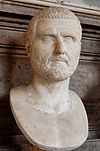
|
Gordian I CAESAR MARCVS ANTONIVS GORDIANVS SEMPRONIANVS AFRICANVS AVGVSTVS |
c. 159 AD, Phrygia? | Proclaimed emperor, whilst Pro-consul in Africa, during a revolt against Maximinus. Ruled jointly with his son Gordian II, and in opposition to Maximinus. Technically a usurper, but retrospectively legitimised by the accession of Gordian III | March 22, 238 AD – April 12, 238 AD | April 238 AD Committed suicide upon hearing of the death of Gordian II. |
21 days |
| Gordian II CAESAR MARCVS ANTONIVS GORDIANVS SEMPRONIANVS ROMANVS AFRICANVS AVGVSTVS |
c. 192 AD, ? | Proclaimed emperor, alongside father Gordian I, in opposition to Maximinus by act of the Senate. | March 22, 238 AD – April 12, 238 AD | April 238 AD Killed during the Battle of Carthage, fighting a pro-Maximinus army |
21 days | |

|
Pupienus CAESAR MARCVS CLODIVS PVPIENVS MAXIMVS AVGVSTVS |
c. 178 AD, ? | Proclaimed joint emperor with Balbinus by the Senate in opposition to Maximinus; later co-emperor with Balbinus. | April 22, 238 AD – July 29, 238 AD | July 29, 238 AD Assassinated by the Praetorian Guard |
3 months |
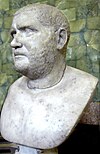
|
Balbinus CAESAR DECIMVS CAELIVS CALVINVS BALBINVS PIVS AVGVSTVS |
? | Proclaimed joint emperor with Pupienus by the Senate after death of Gordian I & II, in opposition to Maximinus; later co-emperor with Pupienus and Gordian III | April 22, 238 AD – July 29, 238 AD | July 29, 238 AD Assassinated by Praetorian Guard |
3 Months |
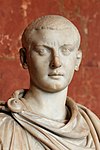
|
Gordian III CAESAR MARCVS ANTONIVS GORDIANVS AVGVSTVS |
January 20, 225 AD, Rome | Proclaimed emperor by supporters of Gordian I & II, then by the Senate; joint emperor with Pupienus and Balbinus until July 238 AD. | April 22, 238 AD – February 11, 244 AD | February 11, 244 AD Unknown; possibly murdered on orders of Philip I |
6 Years |
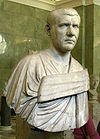
|
Philip I CAESAR MARCVS IVLIVS PHILIPPVS AVGVSTVS with Philip II |
c. 204 AD, Shahba, Syria | Praetorian Prefect to Gordian III, took power after his death; made his son Philip II co-emperor in summer 247 AD | February 244 AD – September/October 249 AD | September/October 249 AD Killed in battle against Trajan Decius, near Verona |
5 Years |

|
Trajan Decius CAESAR GAIVS MESSIVS QVINTVS TRAIANVS DECIVS AVGVSTVS with Herennius Etruscus |
c. 201 AD, Budalia, Lower Pannonia | Governor under Philip I; proclaimed emperor by Danubian legions and defeated Philip in battle; made his son Herennius Etruscus co-emperor in early 251 AD | September/ October 249 AD – June 251 AD | June 251 AD Both killed in the Battle of Abrittus fighting against the Goths |
2 Years |
| File:082 Hostilianus.jpg | Hostilian CAESAR CAIVS VALENS HOSTILIANVS MESSIVS QVINTVS AVGVSTVS |
Rome | Son of Trajan Decius, accepted as heir by the Senate | June 251 AD – late 251 AD | September/October 251 AD Natural causes (plague) |
4-5 Months |

|
Trebonianus Gallus CAESAR GAIVS VIBIVS TREBONIANVS GALLVS AVGVSTVS with Volusianus |
206 AD, Italia | Governor of Moesia Superior, proclaimed emperor by Danubian legions after Trajan Decius's death (and in opposition to Hostilian); made his son Volusianus co-emperor in late 251 AD. | June 251 AD – August 253 AD | August 253 AD Assassinated by their own troops, in favour of Aemilian |
2 Years |
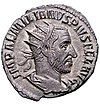
|
Aemilian CAESAR MARCVS AEMILIVS AEMILIANVS AVGVSTVS |
c. 207 AD Africa | Governor of Moesia Superior, proclaimed emperor by Danubian legions after defeating the Goths; accepted as emperor after death of Gallus | August 253 AD – October 253 AD | September/October 253 AD Assassinated by his own troops, in favour of Valerian |
2 Months |
| Valerian CAESAR PVBLIVS LICINIVS VALERIANVS AVGVSTVS |
c. 195 AD | Governor of Noricum and Raetia, proclaimed emperor by Rhine legions after death of Gallus; accepted as emperor after death of Aemilian | October 253 AD – 260 AD | After 260 AD Captured in Battle of Edessa against Persians, died in captivity |
7 Years | |

|
Gallienus CAESAR PVBLIVS LICINIVS EGNATIVS GALLIENVS AVGVSTVS with Saloninus |
218 AD | Son of Valerian, made co-emperor in 253 AD; his son Saloninus is very briefly co-emperor in c. July 260 before assassination by Postumus. | October 253 AD – September 268 AD | September 268 AD Murdered at Aquileia by his own commanders. |
15 Years |
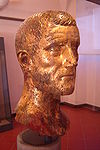
|
Claudius Gothicus CAESAR MARCVS AVRELIVS CLAVDIVS AVGVSTVS |
May 10, 213 AD/214 AD, Sirmium | Victorious general at Battle of Naissus, seized power after Gallienus's death | September 268 AD – January 270 AD | January 270 AD Natural causes (plague) |
1 Year, 4 Months |

|
Quintillus CAESAR MARCVS AVRELIVS CLAVDIVS QVINTILLVS AVGVSTVS |
?, Sirmium | Brother of Claudius Gothicus, seized power after his death | January 270 AD – 270 AD | 270 AD Unclear; possibly suicide or murder |
Unknown |
| Aurelian CAESAR LVCIVS DOMITIVS AVRELIANVS AVGVSTVS |
September 9, 214 AD/215 AD, Sirmium | Proclaimed emperor by Danubian legions after Claudius II's death, in opposition to Quintillus | September(?) 270 AD – September 275 AD | September 275 AD Assassinated by Praetorian Guard |
5 Years | |
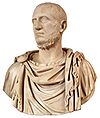
|
Tacitus CAESAR MARCVS CLAVDIVS TACITVS AVGVSTVS |
c. 200, Interamna | Elected by the Senate to replace Aurelian, after a short interregnum | September 25, 275 AD – June 276 AD | June 276 AD Natural causes (possibly assassinated) |
9 Months |
| Florian CAESAR MARCVS ANNIVS FLORIANVS AVGVSTVS |
? | Brother of Tacitus, elected by the army in the west to replace him | June 276 AD – September? 276 AD | September? 276 AD Assassinated by his own troops, in favour of Probus |
3 Months | |
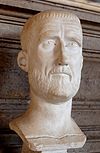
|
Probus CAESAR MARCVS AVRELIVS PROBVS AVGVSTVS |
232 AD, Sirmium | Governor of the eastern provinces, proclaimed emperor by Danubian legions in opposition to Florian | September? 276 AD – September/ October 282 AD | September/ October 282 AD Assassinated by his own troops, in favour of Carus |
6 Years |

|
Carus CAESAR MARCVS AVRELIVS CARVS AVGVSTVS |
c. 230 AD, Narbo | Praetorian Prefect to Probus; seized power either before or after Probus was murdered | September/ October 282 AD – late July/ early August 283 AD | Late July/early August 283 AD Natural causes? (Possibly killed by lightning) |
10-11 Months |

|
Numerian CAESAR MARCVS AVRELIVS NVMERIVS NVMERIANVS AVGVSTVS |
? | Son of Carus, succeeded him jointly with his brother Carinus | Late July/early August 283 AD – 284 AD? | 284 AD Unclear; possibly assassinated |
1 Year |
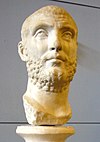
|
Carinus CAESAR MARCVS AVRELIVS CARINVS AVGVSTVS |
? | Son of Carus, succeeded him jointly with his brother Numerian | Late July/early August 283 AD – 285 AD | 285 AD Died in battle against Diocletian? |
2 Years |
The Dominate
Tetrarchy and Constantinian dynasty
| Portrait | Name | Birth | Succession | Reign | Death | Time in Office |
|---|---|---|---|---|---|---|

|
Diocletian CAESAR GAIVS AVRELIVS VALERIVS DIOCLETIANVS AVGVSTVS |
c. December 22, 244 AD, Salona | Proclaimed emperor by army after death of Numerian, and in opposition to Carinus; adopted Maximian as senior co-emperor in 286 AD | November 20, 284 AD – May 1, 305 AD | 3 December 311 AD Abdicated; died of natural causes in Aspalatos |
20 years |

|
Maximian CAESAR GAIVS AVRELIVS VALERIVS MAXIMIANVS AVGVSTVS |
c. 250 AD, near Sirmium, Pannonia | Adopted as senior co-emperor ('Augustus') in the west by Diocletian in 286 AD | April 1, 286 AD – May 1, 305 AD | 310 AD Abdicated with Diocletian; twice tried to regain throne with, and then from Maxentius; captured by Constantine I and committed suicide at his behest |
19 years |

|
Constantius I Chlorus CAESAR GAIVS FLAVIVS VALERIVS CONSTANTIVS AVGVSTVS |
March 31 c. 250 AD, Dardania, Moesia | Adopted as junior co-emperor ('Caesar') and heir by Maximian in 293 AD | May 1, 305 AD – July 25, 306 AD | 306 AD Natural causes |
1 year and 2 months |
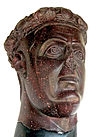
|
Galerius CAESAR GALERIVS VALERIVS MAXIMIANVS AVGVSTVS |
c. 260 AD, Felix Romuliana, Moesia Superior | Adopted as junior co-emperor ('Caesar') and heir by Diocletian in 293 AD | May 1, 305 AD – May 311 AD | 311 AD Natural causes |
6 years |

|
Severus II FLAVIVS VALERIVS SEVERVS AVGVSTVS |
? | Adopted as junior co-emperor ('Caesar') and heir by Constantius I Chlorus in 305 AD; succeeded as Augustus in 306; opposed by Maxentius and Constantine I | Summer 306 AD – March/ April 307 AD | September 16, 307 AD Captured by Maxentius and forced to commit suicide (or murdered) |
1 year |

|
Constantine I CAESAR FLAVIVS CONSTANTINVS VALERIVS AVGVSTVS |
February 27 c. 272 AD, Naissus, Moesia Superior | Son of Constantius I Chlorus, proclaimed emperor by his father's troops; accepted as Caesar (west) by Galerius in 306 AD; promoted to Augustus (west) in 307 AD by Maximian after death of Severus II; refused relegation to Caesar in 309 AD | 25 July 306 AD – May 22, 337 AD | May 22, 337 AD Natural causes |
31 years |
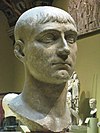
|
Maxentius MARCVS AVRELIVS VALERIVS MAXENTIVS AVGVSTVS |
c. 278 AD, ? | Son of Maximian, seized power in 306 after death of Constantius I Chlorus, in opposition to Severus and Constantine I; made Caesar (west) by Maximian in 307 AD after the death of Severus | 28 October 306 AD – October 28, 312 AD | October 28, 312 AD Died at the Battle of the Milvian Bridge, against Constantine I |
6 years |
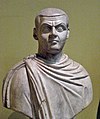
|
Maximinus II CAESAR GALERIVS VALERIVS MAXIMINVS AVGVSTVS |
November 20 c. 270 AD, Dacia Aureliana | Nephew of Galerius, adopted as Caesar and his heir in 305 AD; succeeded as Augustus (shared with Licinius I) in 311 AD | May 1, 311 AD – July/August 313 AD | July/August 313 AD Defeated in civil war against Licinius I; probably committed suicide thereafter |
2 years |

|
Licinius I CAESAR GAIVS VALERIVS LICINIVS AVGVSTVS with Valerius Valens Martinian |
c. 250 AD, Felix Romuliana, Moesia Superior | Appointed Augustus in the west by Galerius in 308 AD, in opposition to Maxentius; became Augustus in the east in 311 AD after the death of Galerius (shared with Maximinus II); defeated Maximinus in civil war to become sole eastern Augustus in 313 AD; appointed Valerius Valens in 317 AD, and Martinian in 324 AD as western Augustus, in opposition to Constantine, both being executed within weeks. | November 11, 308 AD – September 18, 324 AD | 325 AD Defeated in civil war against Constantine I in 324 AD and captured; executed on the orders of Constantine the next year |
16 years |

|
Constantine II CAESAR FLAVIVS CLAVDIVS CONSTANTINVS AVGVSTVS |
316 AD, Arles | Son of Constantine I; appointed Caesar in 317 AD, succeeded as joint Augustus with his brothers Constantius II and Constans I | May 22, 337 AD – 340 AD | 340 AD Died in battle against Constans I |
3 years |

|
Constantius II CAESAR FLAVIVS IVLIVS CONSTANTIVS AVGVSTVS |
August 7, 317 AD, Sirmium, Pannonia | Son of Constantine I; succeeded as joint Augustus with his brothers Constantine II and Constans I; sole emperor from 350 AD | May 22, 337 AD – November 3, 361 AD | 361 AD Natural causes |
24 Years |

|
Constans I CAESAR FLAVIVS IVLIVS CONSTANS AVGVSTVS |
320 AD, ? | Son of Constantine I; succeeded as joint Augustus with his brothers Constantine II and Constantius II | May 22, 337 AD – 350 AD | 350 AD Assassinated on the orders of the usurper Magnentius |
13 Years |

|
Vetranio | ?, Moesia | General of Constans I, proclaimed Caesar against Magnentius and temporarily accepted as Augustus of the west by Constantius II. | March 1 – December 25, 350 AD | c. 356 As a private citizen, after abdication. |
9 Months |

|
Julian II CAESAR FLAVIVS CLAVDIVS IVLIANVS AVGVSTVS |
331 AD/332 AD, Constantinople, Thracia | Cousin of Constantius II; made Caesar of the west in 355 AD; proclaimed Augustus by his troops in 360; sole emperor after the death of Constantius | February 360 AD – June 26, 363 AD | June 26, 363 AD Mortally wounded in battle |
3 Years |

|
Jovian CAESAR FLAVIVS IOVIANVS AVGVSTVS |
331 AD, Singidunum, Moesia | General of Julian's army; proclaimed emperor by the troops on Julian's death | June 26, 363 AD – February 17, 364 AD | February 17, 364 AD Natural causes (suffocated on fumes) |
1 Year |
Valentinian dynasty
| Portrait | Name | Birth | Succession | Reign | Death | Time in Office |
|---|---|---|---|---|---|---|

|
Valentinian I FLAVIVS VALENTINIANVS AVGVSTVS |
321 AD, Cibalae, Pannonia | Elected to replace Jovian by the army | February 26, 364 AD – November 17, 375 AD | November 17, 375 AD Natural causes |
11 Years |

|
Valens FLAVIVS IVLIVS VALENS AVGVSTVS |
328 AD, Cibalae, Pannonia | Brother of Valentinian I, appointed co-augustus (for the east) by him | March 28, 364 AD – August 9, 378 AD | August 9, 378 AD Killed in Battle of Adrianople against the Goths |
14 Years |

|
Gratian FLAVIVS GRATIANVS AVGVSTVS |
April 18/May 23, 359 AD, Sirmium, Pannonia | Son of Valentinian I, appointed 'junior' Augustus by him in 367, became 'senior' augustus (for the west) after Valentinian's death. | August 4, 367 AD – August 25, 383 AD | August 25, 383 AD Murdered by rebellious army faction |
16 Years |

|
Valentinian II FLAVIVS VALENTINIANVS INVICTVS AVGVSTVS |
371 AD, Milan, Italia | Son of Valentinian I, proclaimed emperor by Pannonian army after Valentinian's death; accepted as co-Augustus for the west by Gratian | November 17, 375 AD – May 15, 392 AD | May 15, 392 AD Unclear; possibly murdered or committed suicide |
17 Years |
Theodosian dynasty
| Portrait | Name | Birth | Succession | Reign | Death | Time in Office |
|---|---|---|---|---|---|---|

|
Theodosius I FLAVIVS THEODOSIVS AVGVSTVS |
January 11, 347 AD, Cauca, Hispania | Appointed as Augustus for the east by Gratian after the death of Valens; became sole 'senior' Augustus after death of Valentinian II | January 1, 379 AD – January 17, 395 AD | January 17, 395 AD Natural causes |
16 Years |

|
Arcadius FLAVIVS ARCADIVS AVGVSTVS EAST |
c. 377 AD, Hispania | Son of Theodosius I; appointed as 'junior' Augustus for the east by Theodosius in 383 (after the death of Gratian); became 'senior' Augustus for the east after his father's death | January 383 AD – May 1, 408 AD | May 1, 408 AD Natural causes |
25 Years |

|
Honorius FLAVIVS HONORIVS AVGVSTVS WEST |
September 9, 384 AD, ? | Son of Theodosius I; appointed as 'junior' Augustus for the west by Theodosius in 393 (after the death of Valentinian II); became 'senior' Augustus for the west after his father's death | January 23, 393 AD – August 15, 423 AD | August 15, 423 AD Natural causes |
30 Years |

|
Theodosius II FLAVIVS THEODOSIVS AVGVSTVS EAST |
April 10, 401 AD, Constantinople? | Son of Arcadius; appointed as 'junior' Augustus for the east by Arcadius in 402; became 'senior' Augustus for the east after his father's death | January 402 AD – July 28, 450 AD | July 28, 450 AD Natural causes |
48 Years |
| Constantius III FLAVIVS CONSTANTIVS AVGVSTVS WEST |
?, Naissus, Moesia Superior | Married to Theodosius I's daughter Galla Placidia, elevated to co-Augustus for the west by Honorius | February 8, 421 AD – September 2, 421 AD | September 2, 421 AD Natural causes |
7 Months | |
| Joannes WEST |
? | A senior civil servant under Honorius, proclaimed emperor by Castinus; not recognized by the Eastern Empire | August 27, 423 AD – May 425 AD | June or July 425 AD Defeated in battle by Theodosius II and Valentinian III, captured and executed |
2 Years | |

|
Valentinian III FLAVIVS PLACIDIVS VALENTINIANVS AVGVSTVS WEST |
July 2, 419 AD, Ravenna, Italia | Son of Constantius III, appointed Caesar for the west by Theodosius II after the death of Honorius, in opposition to the Johannes; became Augustus for the west after the defeat of Johannes | October 23, 424 AD – March 16, 455 AD | March 16, 455 AD Assassinated, possibly at the behest of Petronius Maximus |
31 Years |
| Marcian FLAVIVS MARCIANIVS AVGVSTVS EAST |
396, Thrace or Illyria | Nominated as successor (and husband) by Pulcheria, sister of Theodosius II | Summer 450 AD – January 457 AD | January 457 AD Natural causes |
7 Years |
The last emperors of the Western Empire
| Portrait | Name | Birth | Succession | Reign | Death | Time in Office |
|---|---|---|---|---|---|---|
| Petronius Maximus FLAVIVS ANICIVS PETRONIVS MAXIMVS AVGVSTVS |
c. 396 AD, ? | Proclaimed himself emperor with the support of the army, after the death of Valentinian III. Not recognized by the Eastern Empire. | March 17, 455 AD – May 31, 455 AD | May 31, 455 AD Murdered, probably stoned to death by the Roman mob |
2 Months | |
| Avitus EPARCHIVS AVITVS AVGVSTVS |
c. 385 AD, ? | Magister militum under Petronius Maximus, proclaimed emperor by the Visigoth king Theoderic II after Petronius's death | July 9, 455 AD – October 17, 456 AD | after 17 October 456 AD Deposed by his Magister militum, Ricimer; became bishop of Placentia; murdered at some point afterwards |
1 Year | |

|
Majorian IVLIVS VALERIVS MAIORIANVS AVGVSTVS |
November 420 AD, ? | Appointed emperor by Ricimer | April 457 AD – August 2, 461 AD | August 7, 461 AD Deposed by his troops (probably at the behest of Ricimer); beheaded on the orders of Ricimer |
4 Years |

|
Libius Severus LIBIVS SEVERVS AVGVSTVS |
?, Lucania, Italia | Appointed emperor by Ricimer. Not recognized by the Eastern Empire. | November 461 AD – August 465 AD | August 465 AD Probably poisoned by Ricimer |
4 Years |

|
Anthemius PROCOPIVS ANTHEMIVS AVGVSTVS |
c. 420 AD | Appointed emperor by Ricimer, with the backing of the eastern emperor Leo I | April 12, 467 AD – July 11, 472 AD | July 11, 472 AD Executed by Ricimer |
5 Years |

|
Olybrius FLAVIVS ANICIVS OLYBRIVS AVGVSTVS |
c. 420 AD | Son-in-law of Valentinian III; appointed emperor by Ricimer. Not recognized by the Eastern Empire. | July 11, 472 AD – November 2, 472 AD | November 2, 472 AD Natural causes |
4 Months |

|
Glycerius FLAVIVS(?) GLYCERIVS AVGVSTVS |
? | Appointed emperor by Gundobad (Ricimer's successor). Not recognized by the Eastern Empire. | March 473 AD – June 474 AD | after 480 AD Deposed by Julius Nepos, became Bishop of Salona, time and manner of death unknown |
1 Year |

|
Julius Nepos FLAVIVS IVLIVS NEPOS AVGVSTVS |
c. 430 AD - 480 AD | Nephew-in-law of the eastern emperor Leo I, appointed emperor in opposition to Glycerius | June 474 AD – August 28, 475 AD (in Italy); – Spring 480 AD (in Gaul and Dalmatia) | 480 AD Deposed in Italy by Flavius Orestes, ruled in balance of Western Empire until assassination in 480. Maintained as figurehead in Italy by Odoacer to his death in 480. |
1 Year/6 Years |

|
Romulus Augustulus FLAVIVS ROMVLVS AVGVSTVS |
c. 460 AD, ?[14] | Appointed by his father, Flavius Orestes. Not recognized by the Eastern Empire. | October 31, 475 AD – September 4, 476 AD (in Italy) | Unknown. Regarded as emperor more from historical convention than accuracy, his rule never extended beyond portions of the Italian peninsula and was not recognized by Eastern Emperor Zeno. Deposed by Odoacer, who then ruled in the name of Julius Nepos until the latter's death in 480, which formally ended the separate western empire; most likely lived out his life on a private villa in obscurity. |
11 months |
Eastern emperors
Leonid dynasty (457–518)
| Name | Reign | Comments | |
|---|---|---|---|
 |
Leo I "the Thracian", "the Butcher", or "the Great" (Λέων Α' ο Θράξ, ο Μακέλλης, ο Μέγας, Flavius Valerius Leo) |
7 February 457 – 18 January 474 |
Born in Dacia ca. 400, and of Bessian origin, Leo became a low-ranking officer and served as an attendant of the Gothic commander-in-chief of the army, Aspar, who chose him as emperor on Marcian's death. He was the first emperor to be crowned by the Patriarch of Constantinople. His reign was marked by the pacification of the Danube frontier and peace with Persia, which allowed him to intervene in the affairs of the western empire, supporting candidates for the throne and dispatching an expedition to recover Carthage from the Vandals in 468. Initially a puppet of Aspar, Leo began promoting the Isaurians as a counterweight to Aspar's Goths, marrying his daughter Ariadne to the Isaurian leader Tarasicodissa (Zeno). With their support, in 471 Aspar was murdered and Gothic power over the army was broken.[15] |
 |
Leo II "the Little" (Λέων Β' ο Μικρός, Flavius Leo) |
18 January – 17 November 474 |
Born ca. 467, he was the grandson of Leo I by Leo's daughter Ariadne and her Isaurian husband, Zeno. Raised to Caesar and then co-emperor in autumn 473, soon after his accession Leo II crowned his father Zeno as co-emperor and effective regent. Died shortly after, possibly poisoned.[16] |
 |
Zeno (Ζήνων, Flavius Zeno) |
17 November 474 – 9 April 491 |
Born ca. 425 in Isauria, originally named Tarasicodissa. As the leader of Leo I's Isaurian soldiers, he rose to comes domesticorum, married the emperor's daughter Ariadne and took the name Zeno, and played a crucial role in the elimination of Aspar and his Goths. He was named co-emperor by his son on 9 February 474, and became sole ruler upon the latter's death, but had to flee to his native country before Basiliscus in 475, regaining control of the capital in 476. Zeno concluded peace with the Vandals, saw off challenges against him by Illus and Verina, and secured peace in the Balkans by enticing the Ostrogoths under Theodoric the Great to migrate to Italy. Zeno's reign also saw the end of the western line of emperors. His pro-Monophysite stance made him unpopular and his promulgation of the Henotikon resulted in the Acacian Schism with the papacy.[17] |
 |
Basiliscus (Βασιλίσκος, Flavius Basiliscus) |
9 January 475 – August 476 |
General and brother-in-law of Leo I, he seized power from Zeno but was again deposed by him. Died in 476/477 |
 |
Anastasius I (Αναστάσιος Α' ο Δίκορος, Flavius Anastasius) |
11 April 491 – 9 July 518 |
Born ca. 430 at Dyrrhachium, he was a palace official (silentiarius) when he was chosen as her husband and Emperor by Empress-dowager Ariadne. He was nicknamed "Dikoros", because of his heterochromia. Anastasius reformed the tax system and the Byzantine coinage and proved a frugal ruler, so that by the end of his reign he left a substantial surplus. His Monophysite sympathies led to wideaspread opposition, most notably the Revolt of Vitalian and the Acacian Schism. His reign was also marked by the first Bulgar raids into the Balkans and by a war with Persia over the foundation of Dara. He died childless.[18] |
Justinian dynasty (518–602)
| Name | Reign | Comments | |
|---|---|---|---|
 |
Justin I (Ιουστίνος Α', Flavius Iustinus) |
July 518 – 1 August 527 |
Born c. 450 at Bederiana (Justiniana Prima), Dardania. Officer and commander of the Excubitors bodyguard under Anastasius I, he was elected by army and people upon the death of Anastasius I. |
 |
Justinian I "the Great" (Ιουστινιανός Α' ο Μέγας, Flavius Petrus Sabbatius Iustinianus) |
1 August 527 – 13/14 November 565 |
Born in 482/483 at Tauresium (Taor), Macedonia. Nephew of Justin I, possibly raised to co-emperor on 1 April 527. Succeeded on Justin I's death. |
 |
Justin II (Ιουστίνος Β', Flavius Iustinus Iunior) |
14 November 565 – 5 October 578 |
Born c. 520. Nephew of Justinian I, he seized the throne on the death of Justinian I with support of army and Senate. Became insane, hence in 573–574 under the regency of his wife Sophia, and in 574–578 under the regency of Tiberius Constantine. |
 |
Tiberius II Constantine (Τιβέριος Β', Flavius Tiberius Constantinus) |
5 October 578 – 14 August 582 |
Born c. 535, commander of the Excubitors, friend and adoptive son of Justin. Was named Caesar and regent in 574. Succeeded on Justin II's death. |
 |
Maurice (Μαυρίκιος, Flavius Mauricius Tiberius) |
14 August 582 – 22 November 602 |
Born in 539 at Arabissus, Cappadocia. Became an official and later a general. Married the daughter of Tiberius II and succeeded him upon his death. Named his son Theodosius as co-emperor in 590. Deposed by Phocas and executed on 27 November 602 at Chalcedon. |
See also
References
Ancient sources
- Tacitus, The Annals of Imperial Rome, Penguin Classics, Michael Grant Publications Ltd, 1971, Reprinted 1985, ISBN 0-14-044060-7
Modern sources
- David J. Breeze, Brian Dobson Hadrian's Wall 4th Edition, Penguin, 2000, ISBN 0-14-027182-1
- Clive Carpenter, The Guinness Book of Kings Rulers & Statesmen, Guinness Superlatives Ltd, 1978, ISBN 0-900424-46-X
- Adrian Goldsworthy, The Fall of the West, Phoenix, 2010, ISBN 978-0-7538-2692-8
- Min Lee (editor), Larousse Pockect Guide Kings & Queens, Larousse, 1995 ISBN 0-7523-0032-6
- Martha Ross, Rulers and Governments of the World, Vol.1 Earliest Times to 1491, Bowker, 1978, ISBN 0-85935-021-5
- Chris Scarre, Brandon Shaw, Chronicle of the Roman Emperors, Thames & Hudson, 1995, Reprinted 2001, ISBN 0-500-05077-5
- R.F.Tapsell, Monarchs Rulers Dynasties and Kingdoms of The World, Thames & Hudson, 1981, Reprinted 1987, ISBN 0-500-27337-5
- ^ a b Rubicon. Holland, T. Abacus, 978-0349115634
- ^ Mos, Henry St.L. B., The Birth of the Middle Ages 395-814, Clarendon Press, London (1935); reprint by Folio Society, London (1998); p. 17)
- ^ Chester G. Starr, A History of the Ancient World, Second Edition. Oxford University Press, 1974. pp. 670–678.
- ^ Asimov, [title?], p. 198.
- ^ Herrin, Judith; "The Glories of Byzantium," Wall Street Journal web: http://online.wsj.com/article/SB10001424052748704615504576172512424600444.html
- ^ http://www.byzantium.xronikon.com/statfirst.html
- ^ Lee, pp. 163–164.
- ^ Goldsworthy, pp. 425–440
- ^ Breeze & Dobson, pp. 251–255
- ^ Moss, Henry, The Birth of the Middle Ages Clarendon Press (London) 1935; Folio Society reprint (London) 1998; pp. 24-28, 281-284.
- ^ http://ancienthistory.about.com/library/bl/bl_lateemps.htm
- ^ (Octavian) Caesar Augustus: Death
- ^ The other claimants for the throne in the Year of the Five Emperors were Pescennius Niger and Clodius Albinus, supported by the Syrian and British legions respectively. Although not completely defeated until 197 AD, they were not formally accepted by the senate and were therefore not technically reigning emperors.
- ^ Romulus Agustulus biographic details.
- ^ Gregory, Timothy E.; Cutler, Anthony (1991). "Leo I". In Kazhdan, Alexander P. (ed.). Oxford Dictionary of Byzantium. New York; Oxford: Oxford University Press. pp. 1206–1207. ISBN 978-0-19-504652-6.
- ^ Kazhdan, Alexander P. (1991). "Leo II". In Kazhdan, Alexander P. (ed.). Oxford Dictionary of Byzantium. New York; Oxford: Oxford University Press. pp. 1207–1208. ISBN 978-0-19-504652-6.
- ^ Gregory, Timothy E. (1991). "Zeno". In Kazhdan, Alexander P. (ed.). Oxford Dictionary of Byzantium. New York; Oxford: Oxford University Press. p. 2223. ISBN 978-0-19-504652-6.
- ^ Gregory, Timothy E. (1991). "Anastasios I". In Kazhdan, Alexander P. (ed.). Oxford Dictionary of Byzantium. New York; Oxford: Oxford University Press. pp. 86–87. ISBN 978-0-19-504652-6.
External links
- Biographies of Roman Emperors.
- List of the Roman Emperors 27 BC – 395 AD
- Portraits and fact files
- The Roman Law Library by Yves Lassard and Alexandr Koptev.
- Timeline of Roman Emperors and Empresses
